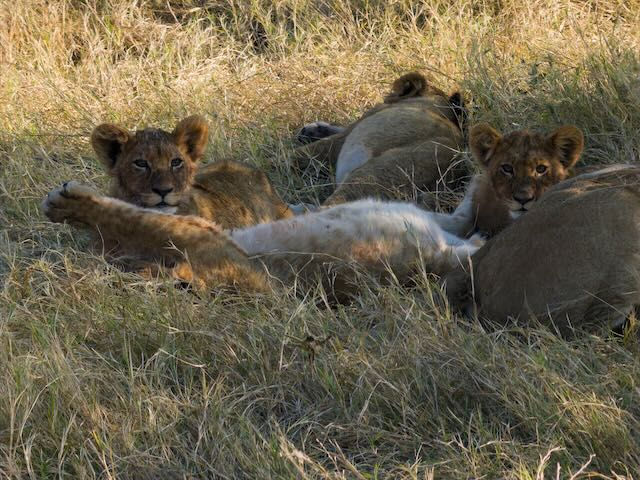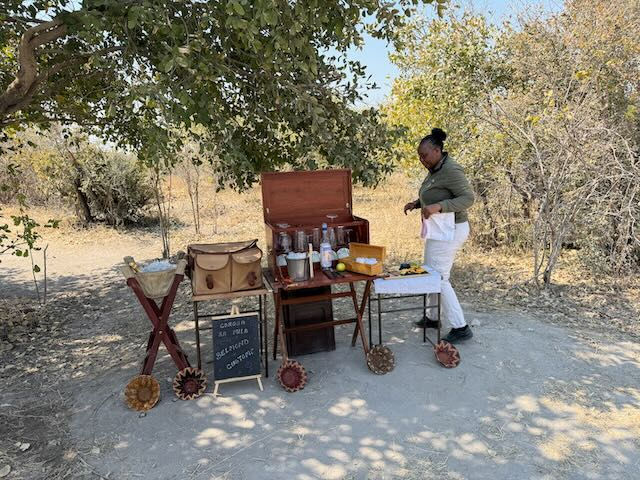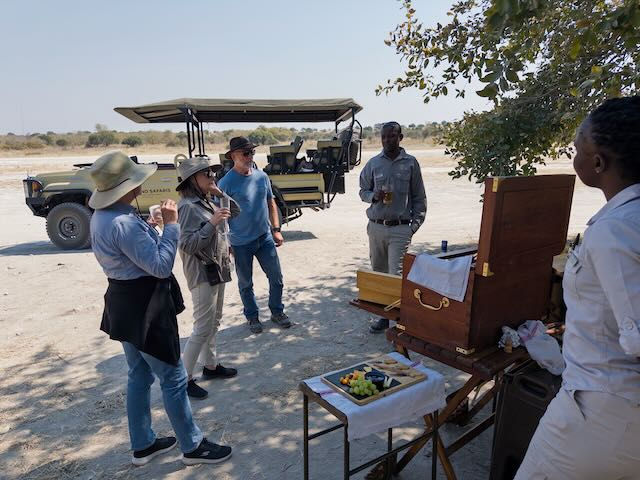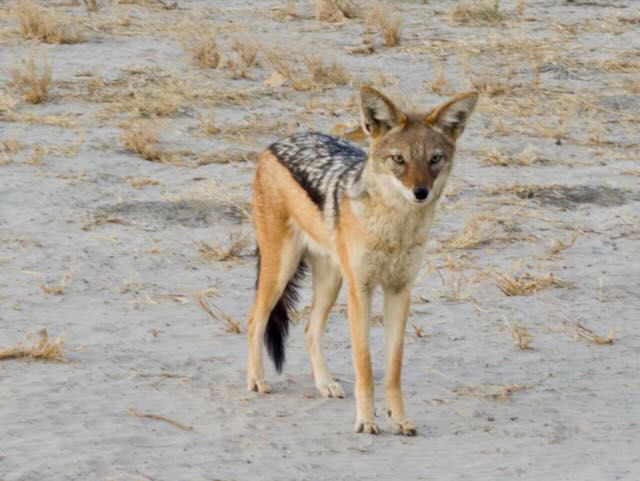Welcome to your last camp - August 6, 2025
- Scott Farnsworth
- Aug 6
- 7 min read
Updated: Aug 12
SUMMARY A final breakfast and game drive at Tubu. Our sweet lion cubs have dined overnight on zebra. We (happily) missed that sight but do get to watch them in their well-fed splendor. We also catch up to the leopard and her two cubs playing with their antelope’s hind leg. Another 12-seater plane hop to Savute Elephant Camp, so named because it sits on a small hill overlooking two watering holes frequented by many animals but especially the elephants. We’re greeted at the airstrip, (ironically called Terminal Five with a wooden bench labeled “Arrivals” and one labeled “Departures) by a team from the camp with a portable but well-stocked bar and cheese platter. We load into a greatly upgraded game drive vehicle and are whisked away to the camp for a late lunch and afternoon game drive. The sparsest amount of game so far but still thrilling. Another Boma dinner with the requisite singing and dancing by the staff. Finally some elephant watching at the watering hole and then bed. - Karen
DETAIL Well it’s time to say good bye to Tubu Tree Camp. It’s been great. We pack and put our tip money for the staff into the box. There’s another box we also tip, it’s the singer’s tip box. And there’s a survey box. They get good marks.
We do one last drive around with Stan. At the beginning of any safari its customary for the guide to ask what you’re particular interests are. Tricia’s is elephants. Mine? Baobab trees. Stan obliges. He shows us one, and explains how being a deciduous succulent it stores starch in the tree (in the bark) before dropping all its leaves. As such, in the winter, if an elephant feels it’s not getting enough starch, it can shred the bark of the Baobab tree and eat it, thereby getting more starch. The tree we’re shown has lots of elephant damage on it, sadly. They do put wire mesh around these trees to try to help them, but the elephants can be pretty tenacious when they want something
We make the rounds of the big cats we know of in the area to see what they’re up to. We see our favorite leopard and we see the lion and her cubs. They’re all still well fed. We come across an ostrich. Stan tells us it’s a male. He can tell, he says, because the feet and beak are orange. So many details.
We come across another elephant skeleton. We can see the mostly hollow honeycomb sponge of the skull. Stan says that’s how the elephant is able to make such a loud noise, with all those echo chambers. We see the elephant’s teeth and learn how they chew front to back rather than ruminants (cows, etc.) which chew side to side. Who knew? The elephants teeth are in a row and they grow forward. New ones appear at the back and the front most ones eventually fall out and get eaten. We don’t want to think about that.
We see where salt has leached out of the ground and left a crystal white powder on the ground’s surface. We’re told you’ll see animals licking this, to get the sodium they need. They also lick discarded bones for calcium. We humans, with our supplements, have it so easy.
African sage, we’re told, is used by hunters to hide their scent. We see a termite mound and Stan tells us that if we want to sleep there for the night (they hold heat well) we should look for mongoose droppings. Their presence indicates that this old termite mound hasn’t become a snake pit. The mongoose are keeping it snake free.
We see a lead wood tree. The wood, we’re told, will sink in the water like a stone. It makes for good, long fires. That’s what we’ve been using in our camps. When the native trappers of old would move around, they’d take some lead wood fire embers to transport the fire to their next camp. They’d take a big round elephant dropping and pry it in half and put the embers in there. It makes it possible to transport the hot coals and keeps the fire going. Who knew?
How are new tribal chiefs selected? Who can make a friction fire. First to make it gets to be chief.
We talk about the trees doing well and those doing less well. Those the elephants like, they eat the leaves and keep them trimmed back. There’s a tree called the poison fish tree (or the apple leaf tree). It has too many tannins and so the elephants do not care of them. They leave them alone. As such, they’re becoming prolific and common and the other “good” trees are being forced out. Sad. The camp people don’t try to intervene. Why is it called ‘poison fish’ tree? Grind up the bark, leaves, and roots, soak it in water, put it in a pond, and the fish can’t breathe. They die and float to the surface. Easy peasy. This isn’t done anymore. Bad form.
Stan drops us at the airport and we say our good byes (and give our guide tips). I take pictures of the funny signs at the airport. We fly at 7,500 feet for 40 minutes, with one stop. We’re leaving the Okavango Delta. We’ll be close to the northern border of Botswana. To our north, not far, is a small sliver of Namibia and above that is Zambia. Such colorful names!
At our new camp, the Savute Elephant Camp, our guide Obie greets us, as does a shiny new, fancy Toyota safari vehicle. No Range Rovers here. It’s really nice and comfortable. By the side of the runway is a small setup with a bar and food. We’re going to like this place. We have Gin and Tonics, the girls have bubbly. There’s cheese, grapes, cape gooseberries, blueberries. We’re guessing the locals don’t eat this way.
We drive off and see animals and learn more of the names of the groups of these animals. A “whoop” of hyenas, a bounce of springboks, a ballet of impalas. So colorful. We see more hornbills. There are different varieties with differing beak colors. The ones with the red beaks are nicknamed “flying chilis” and those with yellow beaks are called “flying bananas”.
We see lots of mongooses, in a big pack. These are banded mongooses. They like to hunt in packs and can easily take down a big, dangerous venomous snake as a group. Some types of mongooses can do it with just a single animal. I like mongooses.
Obie, our guide, points out a gnu. We’d heard of these but had we seen one? Yes. We’ve been calling it by its other name, wildebeest. They supposedly have very poor eyesight. They get easily lost and separated from the herd. They find a big field (easy to identify) and bingo, they have a new home. They’re thus frequently lone bachelors. They pray for a similarly nearsighted female wildebeest to come along.
We see impala, of course, and lions. We see steenbok. They’re small, like a big dog, but not very heavy. They have short, straight horns. They hang out alone (unless it’s time to mate). Like a cat they dig a hole for their poop and cover it when they’re done. They don’t want to bring attention to themselves. When they are discovered they’ll roll up into a little ball and make themselves look like a rock. Nothing to see here, Mr. Lion, move along.
We see trees with big nests in them. Weavers nests. We hear that these birds will weave extra nests as decoys for the raptors.
Around a corner we see a camp of a dozen or so big tents and a camp cook fixing dinner. This is a mobile safari camp. These people are like us, but their lodgings are mobile and their walls are thin rip-stop nylon. Not sure it would stop a lion. Thank you, no, we all agree.
We have another of those special dinners. They normally do like Tuesdays and Saturdays but if there aren’t enough people in the camp, they slide it a day, so we get lucky! There’s more singing and dancing and they pull us up to dance. We gladly join them. Great fun.
Photos

Always on our daily todo list: check up on any known cat locations. First: the family with six cubs whose dad took down a zebra recently. They've eaten and they're sleeping. Just "lion" around, as our guide says.

Similarly the totes adorbs leopard cubs are still in their tree with their impala meal.

While gnawing on the impala carcas it falls out of the tree. Here one of the cute leopard cubs is carrying around an impala leg. Gross.

High on my list of wishes? To see some baobab trees. This is the most impresive one around these parts. It's trunk shows lots of abuse by elephants over the years.

On our morning game drive our road turns into a (hopefully shallow) river for a while. The Range Rover gets us through it without issue.

We find another elephant skull and Stan puts the tusks back in where they belong. We continue our pachydermy dental lesson by looking at the teeth.

Eventually we fly off to our next safari home.

On landing they make us feel welcome with a bar and snacks set up next to the runway. Now that's a welcome!

No more Range Rovers for us. Here it's a Toyota. Very well appointed, new, and comfortable. This will do.

Enjoying gin and tonics (and bubbly) as we get to know our new hosts.

We weren't the only ones drinking. This giraffe does the necessary bending and stretching to get to the water. They can get the water into their mouths, but have to raise their heads to get it to flow down into their belly. On the back is one of the ever present ox pecker birds, tending to the bugs.

At camp, song and dance welcome us. Great fun.

Our room, er, tent, is smaller than other camps, but it has an A/C and heater. It's quite comfortable.

On our afternoon drive we see a huge group of banded mongooses (mongeese?). This is just four of them.

We startle a grazing gnu, aka wildebeest. He's a batchelor, we're told, likely due to his poor eyesight. He didn't realize he was getting too far from his herd. Next thing he knows, he's a loner.

We find a lion family who apparently recently ate. They're full and ready to sleep it off.

We see a lot of horn bill birds. Some have red bill and some yellow. They're nicknamed flying chilis and flying bananas. Those are the only two varities with food nicknames.

We get to see more baobab trees. This one is around 800 years old. It shows lots of abuse by local elephants.

At our sundowner stop for cocktails while we watch the sunset this guy showed up. He's a jackle and he's apparently relized humans at sundowners are likely to drop yummy food. This doesn't make the guides happy, but what can you do?

Another special dinner and show (singing and dancing). Great fun and we're invited to (and do) join in.

The other show was after dinner with lots of elephants visiting the camp's water holes for a drink.



Comments